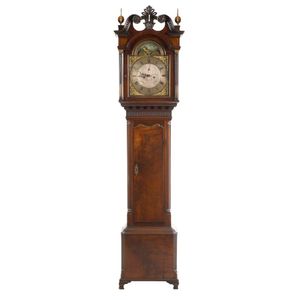George III Oak Long Case Clock by S Collier
You must be a subscriber, and be logged in to view price and dealer details.
Subscribe Now to view actual auction price for this item
When you subscribe, you have the option of setting the currency in which to display prices to $Au, $US, $NZ or Stg.
- Oak - Native to Europe and England, oak has been used for joinery, furniture and building since the beginning of the medieval civilisation. It is a pale yellow in colour when freshly cut and darkens with age to a mid brown colour.
Oak as a furniture timber was superceded by walnut in the 17th century, and in the 18th century by mahogany,
Semi-fossilised bog oak is black in colour, and is found in peat bogs where the trees have fallen and been preserved from decay by the bog. It is used for jewellery and small carved trinkets.
Pollard oak is taken from an oak that has been regularly pollarded, that is the upper branches have been removed at the top of the trunk, result that new branches would appear, and over time the top would become ball-like. . When harvested and sawn, the timber displays a continuous surface of knotty circles. The timber was scarce and expensive and was used in more expensive pieces of furniture in the Regency and Victorian periods. - Subsidiary Dial - On a clock or watch, a subsidiary dial, also called an auxiliary dial, is a dial that is secondary to the main dial and may show seconds, day of the week or month, or strike silent. A subsidiary dial may be within our outside the main dial, and a clock or watch may have several subsidiary dials.
- Hood - In longcase clocks, the hood is the wooden case that surrounds the works and dial, and includes the glass front, which is usually hinged, so the door can be opened to wind the clock or adjust the time. In 18th and 19th century longcase clocks the hood usually slides forward for removal, allowing access to the works.
- Rosewood - A dense timber that varies in shade to very light brown to almost black. When rosewood is cut and sanded the colour of the timber will turn black, and after polishing and exposure to daylight, the surface will gradually lighten over time to light brown with black streaks.
The name comes from the odour emanating from the timber when it is planed, sanded or cut.
Rosewood was very popular for use in Victorian furniture in the second half of the 19th century, and at that time most of the rosewood was imported from Brazil. However it also grows in India and Indonesia.
It is used in the sold for chairs and table legs, but for carcase furniture such as side cabinets and bookcases, and for table tops it is always used as a veneer. - Finial - An architectural decoration, found on the upper parts of of an object. On furniture they are usually found on pediments, canopies and shelf supports. On smaller ceramic or silver items, such as spoons, they may decorate the top of the item itself, or the lid or cover where they provide a useful handle for removal.
Finials have a variety of shapes and forms. They may be urn-shaped, baluster shaped round or spiral, but usually taper into an upper point. Many real life shapes may also be used as finials, such as pineapples, berries, pinecones, buds, lotus and acorns. Sometimes animals such as a lion are depicted, or fish and dolphins. - Date Aperture - A date aperture is a cut out section in the face of a watch or clock, displaying the day of the month.
- George Iii - George III (1738 - 1820) was King of Great Britain and Ireland from 1760 to 1820.
This item has been included into following indexes:
Visually similar items

A George III mahogany longcase clock, the dial signed William Lee, Leicester the brass Roman numeral dial with subsidiary seconds dial and calendar, housing an anchor escapement on one bell, 223.5 cm high

George III longcase clock, the arched hood with three eagle and orb brass finials, fluted column supports, the arched painted dial with moonphase, Roman numerals, subsidiary second and calendar dials, in mahogany and inlaid case by Eli Tremfell of Lanham

A mahogany longcase clock, by John Aspinwall Liverpool, circa 1800, circular silvered dial framed by pierced spandrels, foliate engraved centre with subsidiary seconds dial and concentric calendar, signed John Aspinwall, Liverpool. The upper arch displays

A Georgian oak longcase clock, English, 19th century
